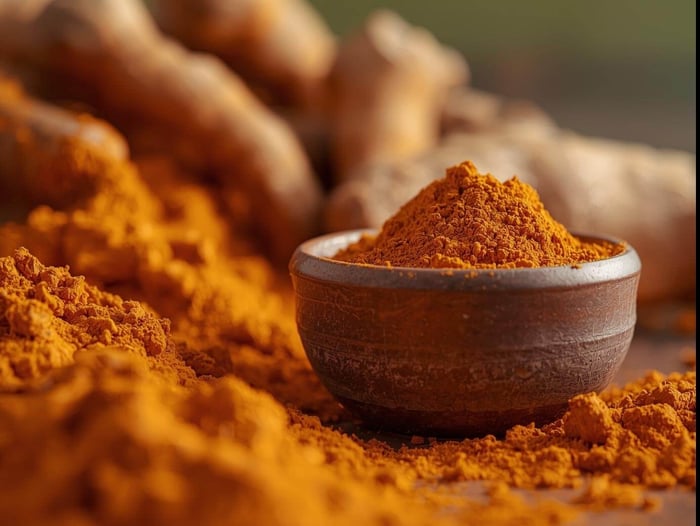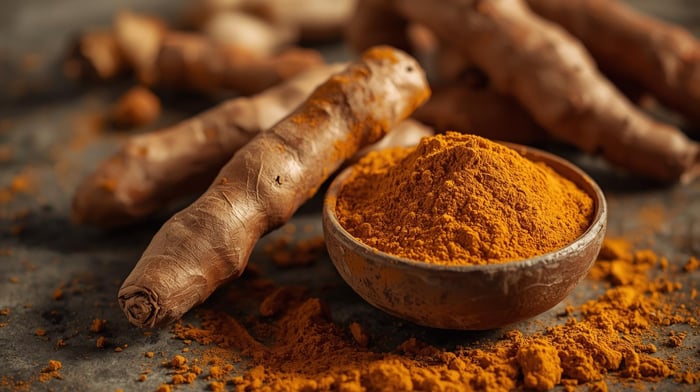Table of Contents
At a Glance
|
Turmeric is one of those ingredients that sparks curiosity whenever natural migraine remedies come up. Known for its deep golden color and warm, earthy flavor, it has a long history in traditional cooking and general wellbeing. More recently, people have begun to ask about turmeric for migraines and how it might play a role in supporting migraine routines.
Here, we’ll take a closer look at turmeric: what it is, why its key compound curcumin has drawn scientific interest, and how it might connect to your everyday routine. We’ll also touch on what current research suggests and share simple ideas for adding turmeric to your diet through meals or drinks. The goal is to give you clear information to act on, along with options to help you decide whether turmeric deserves a place in your life.
What Is Turmeric?
The bright yellow spice turmeric comes from the root of the Curcuma longa plant, a member of the ginger family. Perhaps best known today for giving curry its golden color, it has been used for centuries in cooking and traditional health practices across South Asia, where it appears in dishes such as dal, sambar, and golden milk (haldi doodh).
As mentioned earlier, the compound most people focus on is curcumin. It’s what gives turmeric much of its golden color and is linked to many of the properties that researchers find interesting. Curcumin is often connected with antioxidant and anti-inflammatory activity in the body, which is one of the main reasons people wonder whether it could have a role in migraine.
That said, curcumin makes up only a small part of turmeric itself. Adding turmeric to meals is usually a gentle, food-first way to try it, and many people are comfortable starting here. Later, you may wish to explore curcumin supplements. These provide a much stronger dose and can make the effects more noticeable. Because curcumin on its own isn’t absorbed very well, it’s often paired with black pepper to help the body make better use of it. We’ll go into this in more detail in the science section.
How Turmeric May Fit into a Migraine Routine
Early research suggests that curcumin may support processes linked to migraine, including inflammation, oxidative stress, pain signaling, and even broader neurological pathways. These potential anti-inflammatory, antioxidative, analgesic, and neuroprotective effects have been noted in both migraine and related conditions (Heidari et al., 2023; Rezaie et al., 2021). While studies remain limited and are often not migraine-specific, these findings help explain why turmeric is gaining interest as a naturally supportive option.
Turmeric’s possible role in migraine is still being explored, but that hasn’t stopped many people from trying it as part of their broader migraine support plan. For most, the easiest starting point is simply adding it to meals. Everyday dishes like soups, rice, or stews can take a small pinch without changing the overall flavor, and in many cases, it can even enhance it.
Another option is to try migraine teas such as turmeric tea or golden milk. Turmeric tea is usually made by steeping the root or powder in hot water, creating a light, earthy drink. Golden milk, on the other hand, mixes turmeric with milk or a milk alternative, and often includes added spices like cinnamon or ginger, for a richer, more warming option. Some people also combine turmeric and ginger for migraines in teas or soothing drinks, as both spices have a long history of traditional use. Both provide a more concentrated but still food-related way to add turmeric to your diet.
Supplements may be worth considering if you are looking for a higher dose of curcumin. If you choose to explore them, it’s best to pick one that also includes black pepper extract (piperine) or another method to support absorption, since curcumin on its own isn’t absorbed very well. Do keep in mind that responses vary from person to person.
It’s important to pay attention to how turmeric feels for you. Some people find it easy to include in their diet, while others may experience mild digestive discomfort if they take too much at once. Paying attention to how it suits you and your migraine strategies can help you decide if it belongs in your routine.
The Science Behind Curcumin and Migraine
Curcumin and Inflammation
Inflammation is often discussed in connection with migraine because it can make the nervous system more sensitive to pain signals. When inflammatory molecules, such as cytokines, are released, they can irritate the nerves and blood vessels around the brain. This irritation may trigger or worsen the pain and sensitivity that many people experience during an attack.
Curcumin has been shown in studies to interact with these inflammatory pathways in the body. It appears to influence cytokines and certain enzymes that play a role in pain and sensitivity, which is why researchers are interested in whether it might help calm some of the processes linked to migraine (Heidari et al., 2023).
Oxidative Stress and Antioxidant Activity
Oxidative stress occurs when the body produces more free radicals than it can neutralize with antioxidants. In migraine, this imbalance is thought to contribute to changes in brain energy metabolism and nerve sensitivity, which may make the brain more vulnerable during an attack.
Curcumin is widely studied for its antioxidant activity, meaning it can help the body counteract free radicals and reduce oxidative stress. This has led researchers to explore whether it could play a protective role in neurological conditions, including migraine (Rezaie et al., 2021).
Pain Pathways and Neuroprotection
Migraine pain is closely tied to changes in how the nervous system processes pain signals. One key molecule often studied is CGRP (calcitonin gene-related peptide), which rises during migraine attacks and is thought to amplify both pain and sensitivity. This is why CGRP has become a major focus in newer migraine treatments.
Curcumin has been investigated for its potential influence on pain pathways, including how it may interact with molecules like CGRP. A clinical trial found that curcumin supplementation reduced CGRP and inflammatory markers, alongside improvements in headache frequency and severity (Rezaie et al., 2021).
Researchers are also interested in its possible neuroprotective effects, which refers to the potential to help protect nerve cells from damage caused by stress or inflammation. Most of this evidence is still at an early stage and comes from small or experimental studies, but it does provide a rationale for looking at curcumin in the context of migraine.
Bioavailability Challenges
One of the main scientific challenges with curcumin is that it is not easily absorbed by the body. Even when people consume turmeric regularly, only a small amount of curcumin makes it into the bloodstream, and this limits how much can reach the brain or other tissues where it might be active. For migraine research, this means that promising effects seen in lab studies do not always carry over clearly into human trials.
To overcome this, many studies and supplement makers combine curcumin with piperine to help increase absorption. Piperine has been shown to increase curcumin’s bioavailability by up to 2,000% in humans (Shoba et al., 1998). Other approaches include creating advanced formulations, such as binding curcumin to fats or developing nanoparticle forms, both are designed to improve how much curcumin the body can absorb (Prasad et al., 2014).
What the Evidence Means
Although curcumin has shown interesting effects in laboratory and early human studies, most of this research has been on a small scale, short-term, or focused on general health rather than specifically on migraine. A few clinical trials in people with migraine have suggested potential benefits, such as reduced headache severity or improvements in inflammation markers, but the evidence is not yet strong enough to draw firm conclusions.
What the science does provide is a reasonable explanation for why turmeric and curcumin have drawn attention as supportive options. For now, they are best seen as part of a broader interest in natural strategies rather than as proven treatments for migraine.
While turmeric is one example of a natural option being explored, some people also turn to broader nutritional strategies designed to support migraine from multiple angles. This is the approach reflected in products like Brain Ritual®.
Practical Ways to Try Turmeric
If you’d like to test turmeric for yourself, here are a few simple and practical approaches:
Golden milk or teas: Try turmeric tea for a light, earthy drink, or golden milk for a creamier option with added warming spices.
Cooking: Add a pinch to everyday meals such as soups, rice, or stews. Turmeric is commonly found in spice blends such as curry powder.
Supplements: If you explore supplements to increase curcumin intake, choose one that also includes piperine to help with absorption.
Everyday tips: Turmeric’s bright color often stains kitchenware, so take care when using it.
Where Brain Ritual® Fits In
If you’ve been exploring natural options like turmeric to help manage migraine more holistically, especially in response to known triggers such as stress, food, or inflammation, nutritional strategies may offer further support. Brain Ritual® was developed by an Oxford-trained neuroscientist as a medical food for the dietary management of migraine.
Rather than relying on a single ingredient like curcumin, Brain Ritual® provides a thoughtfully designed blend of nutrients that support brain energy, neurotransmitter balance, and hydration. It also includes ketone bodies as an efficient alternative fuel for the brain, reflecting their growing importance in migraine nutrition. The formula is designed to simplify your routine by combining science-backed ingredients into one easy daily serving.
If you’d like to learn more, you can find details or make a purchase here.
Common Questions
What’s the difference between turmeric and curcumin?
Turmeric comes from the root of the Curcuma longa plant, which is usually dried and ground into the golden spice you see in cooking. Curcumin is one of the natural compounds found within turmeric, and it’s the component that researchers study most often in relation to health. While turmeric is commonly used in food for its flavor and color, curcumin is usually taken as a concentrated supplement by people who want to support their health.
Are there any safety concerns with turmeric?
Adding turmeric to food is generally considered safe for most people. Larger amounts, particularly from supplements, may sometimes cause an upset stomach. Curcumin can also interact with certain medications, such as blood thinners, so it’s important to take care if you use prescribed drugs and to check with your doctor or pharmacist before adding supplements.
Does turmeric require black pepper to work?
Curcumin on its own is not absorbed very efficiently by the body. This is why supplements often include black pepper extract (piperine) or use other techniques, such as binding curcumin to fats or creating nanoparticle forms, to improve absorption. When using turmeric in food, a little black pepper can help, but the overall effect is more limited than in supplements.
Is turmeric good for migraines and does turmeric help with headaches?
Turmeric and its key compound curcumin have been studied for their potential antioxidant and anti-inflammatory properties. Early research suggests they may support processes linked to migraine, such as inflammation, oxidative stress, and pain sensitivity. This has led to interest in whether turmeric could also play a role in headaches more generally. The evidence is still limited and not always migraine-specific, so turmeric is best seen as one possible tool within a broader interest in natural approaches rather than a stand-alone solution.
How quickly would I notice any effect?
Everyone’s experience with turmeric is different. Some people try it in their diet and feel it supports their general wellbeing, while others may not notice a change at all. Supplements provide a higher dose of curcumin, but responses vary widely from person to person.
Final Thoughts
The kitchen spice turmeric has become a subject of growing interest for its potential role in migraine support. Its active compound, curcumin, has shown promise in early research, particularly around inflammation, oxidative stress, and pain pathways. This evidence is still developing and not always migraine-specific.
For most people, adding turmeric to food or drinks is an approachable way to try it. Supplements can provide a more concentrated source of curcumin, but they are not essential for everyone. It’s worth thinking about how they fit with your overall health and whether they interact with any medications you take.
Turmeric is perhaps best viewed as one of many possible tools within a broader migraine routine. Paying attention to how it feels for you, and combining it with other strategies that fit your lifestyle, may help support your response to migraine.




